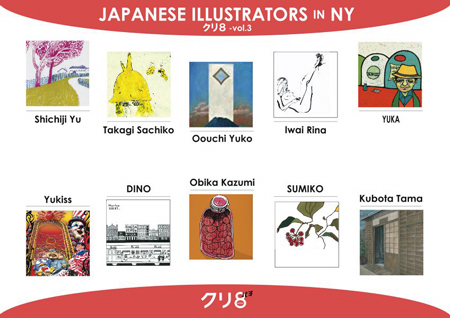
November Exhibition News(Click Here!) Wednesday, November 1th --- Saturday, November 25th, 2006 Reception: Friday, November 3rd, 5:00-7:30PM Gallery Hours |
 |
|---|
JAPANESE ILLUSTRATORS IN NY Cre8-vol.3NYCoo Gallery is pleased to announce it's November exhibition "Japanese Illustrators in NY-Cre 8, vol. 3", and eager to extend our invitation to this group exhibition with the overflowing energy and willingness representing Japan today. "Japanese Illustrators in NY" is planned by the illustrators' agency, Cre 8, in Tokyo and its third exhibition at the NYCoo Gallery. Cre 8 states, "We present ten Japanese artists with works are not stereotypic but representative of Japan now." NYCoo Gallery describes their intent as " To let people in New York see an aspect of the younger Japanese generation's mind and society which is filled with illustrations and designs." And, "They choose careers as illustrators because it is considered cool and trendy to sell copyrights to support their lives. illustrations floods bookstores not only in fashion magazines but in every possible publication, commuter trains, newspapers inserts, pamphlets handed out on street corners and television commercials. In contrast, New York is a city with out illustrations." The exhibiting ten artists are: Yuko Oouchi, Tama Kubota, Sumiko, Yuka, Yakiss, Chikako Takagi, Dino, Rina Iwai, and Yuu Hichiji, and Kazumi Obika all of whom are showing in New York for the first time. However, Dino who lives in Fukuoka chooses to work primary with New York as his theme, and Tokyo based Yuka with European landscapes and people. The variety of within the group is impressive. Many things come to my in visiting their web site, viewing their works, and reading their statements. "My goal is to be original while responding to the needs of my clients. My motto is to be reliabile, precise, and prompt. This is a clientele based service business." says Yukiss who resides in Osaka. Her work entitled "Color of Osaka" is filled with bright colors, eclectic imagery, and complex compositional structures with a time-consuming strong sense of particular concern to details which seems to contradiction her statement. This could be charactaritic of an Osakaite. Tama Kubota of Tokyo states, " I want to create images that awaken and recollect one's memories and sentiments. Her descriptive ability and compositional organization convincingly portray rustic Japanese wooden houses of the early Showa Period, the 1930's. However, one wonders if the cultural flavor of that time period can be construed by those of a different culture. The works of the American illustrator, Norman Rockwell, have a universality to evoke one's emotion. Could that be because our minds have been brainwashed with Americanism? Yuu Shichiji states, "I draw images found in daily life and place them in my own world using my forms and colors." She adheres to painting her series on small square formats. It is said that true art must reflect the reality of life, and further more, art making is life itself. Shichiji's format may needed to be enlarged to encompass a larger reality. When asked what she art expression means to her, Yuko Oouchi answers, "It is like water." Water can change from solid to liquid and to a gaseous state, Depending on the shape of the container liquid water can become any shape. In the same way, art expression should be free and unrestrained. The verbal expression plays an important role in image making in this artist. By verbally expressing themselves, artists can in turn perceive of their visual expression from a different perspective. Sumiko's refined sense of design and color could reach a higher level of expression by objectively reexamining her own statement, "I express things that I'm drawn to in my own way." Chikako Takagi's work entitled "Travel by Rough Sea" seems playfully ironic, "I will remain strong and not be swayed." Kazumi Obika who lives in Kagawa Prefecture where it seldom snows paints a snowman in a work entitled "me too" and states, "I visualize what and how I feel." Rina Iwai says that she draws female figure with waribashi, disposible wooden chopsticks and bokuju, bottled sumi ink. Bijinga, the genre of portraying beautiful women is here drawn by a woman artist. She states, "I love to draw the smooth curves of the feminine figure."
|
||
Gallery writer : Hitoshi Nakazato
|
||
Illustrators
|